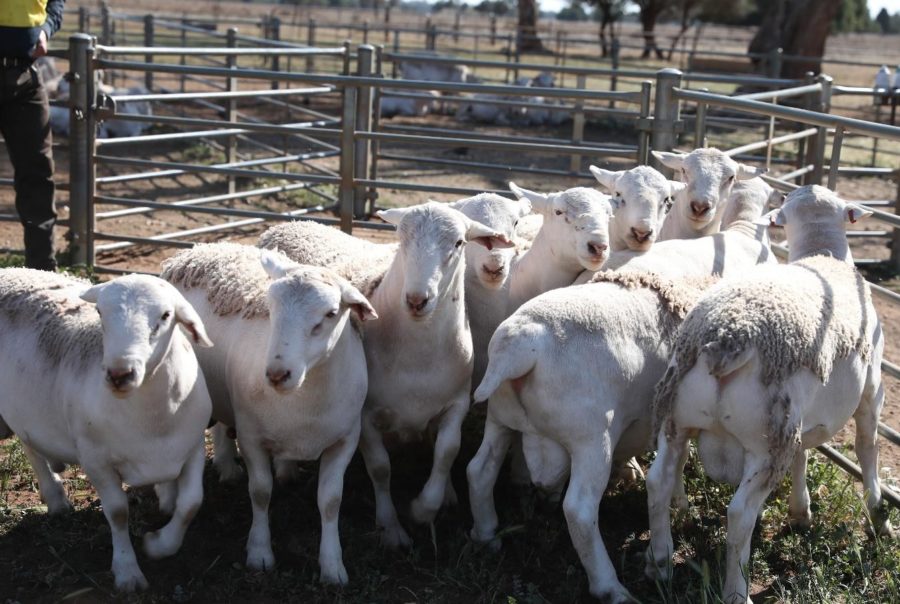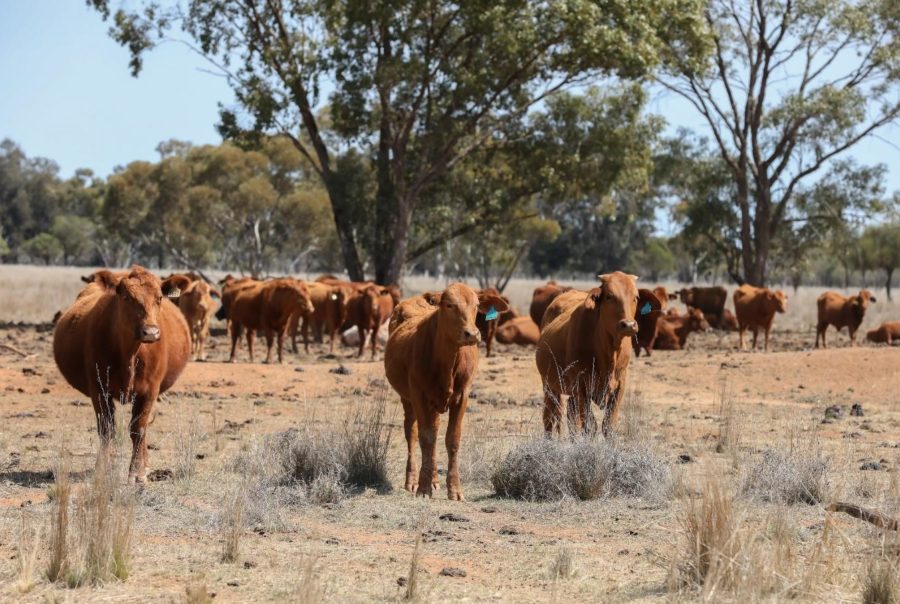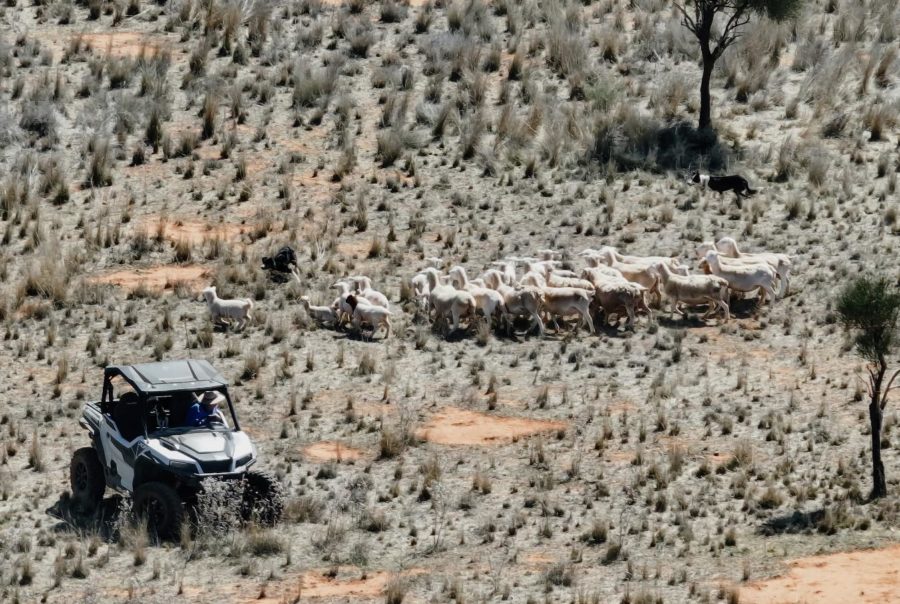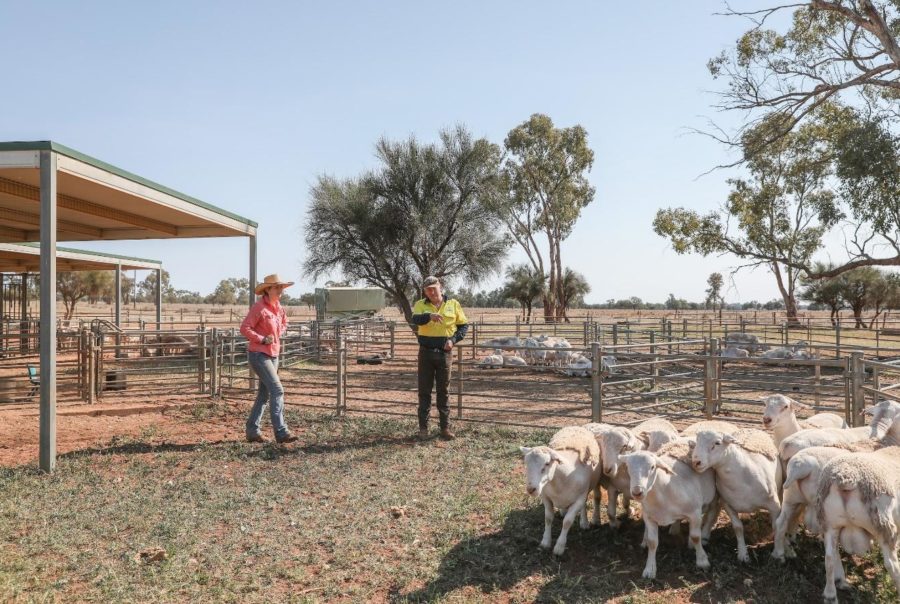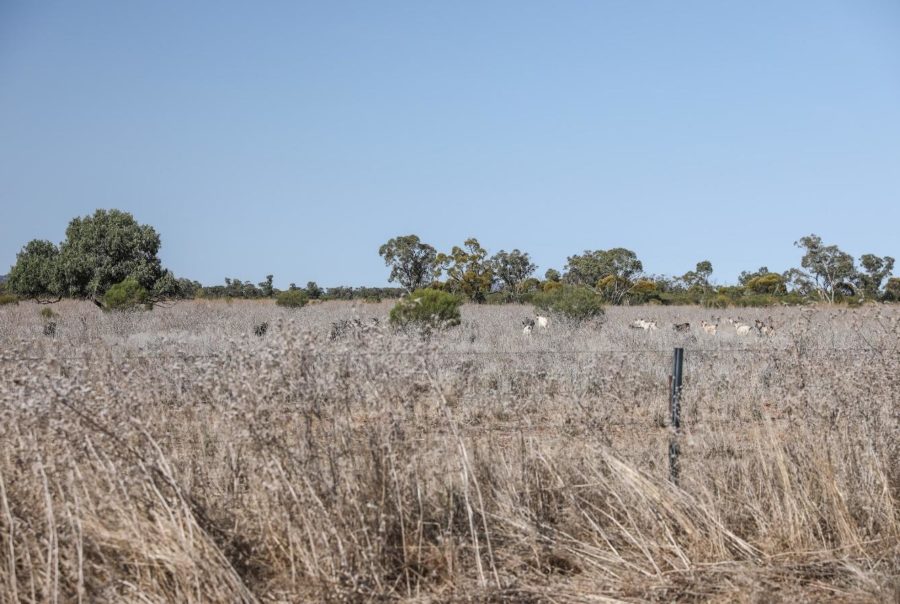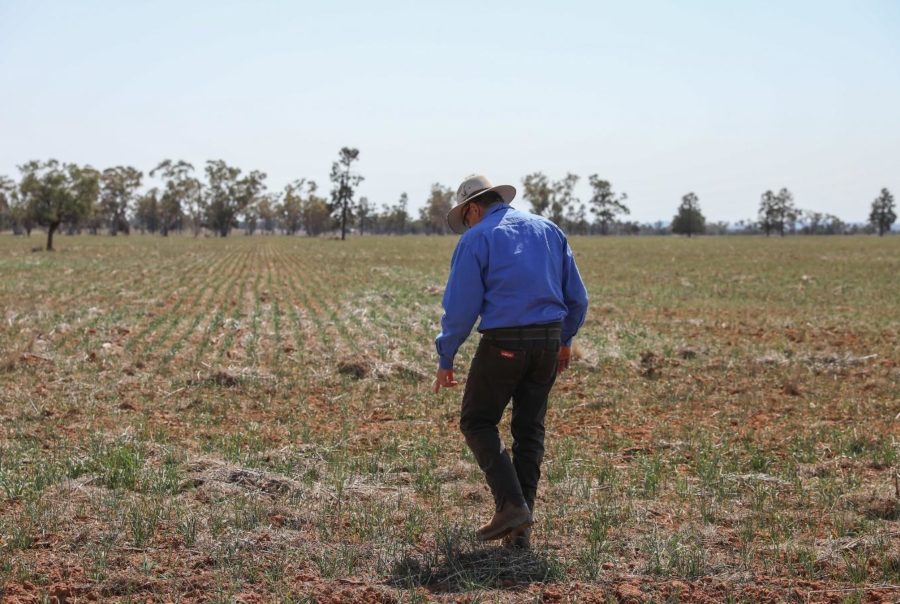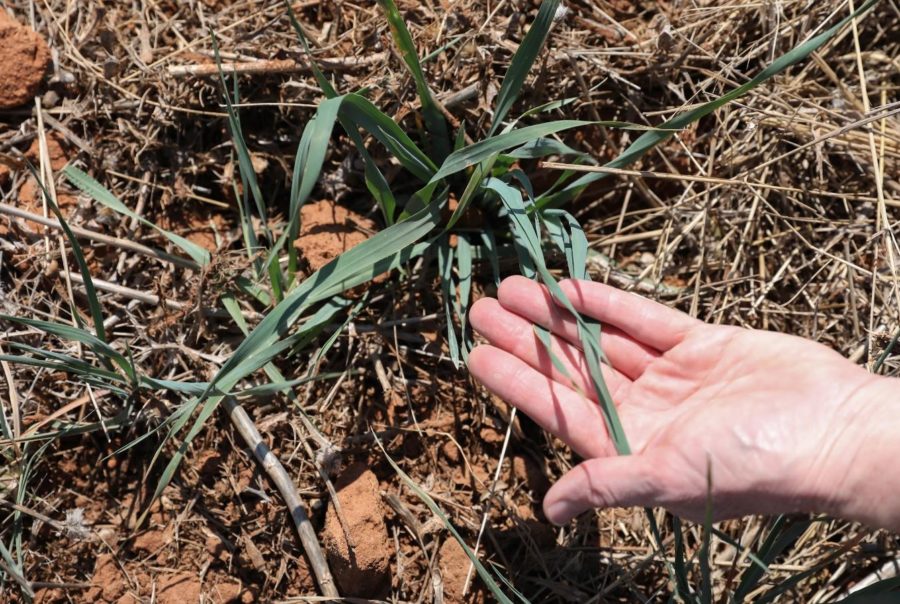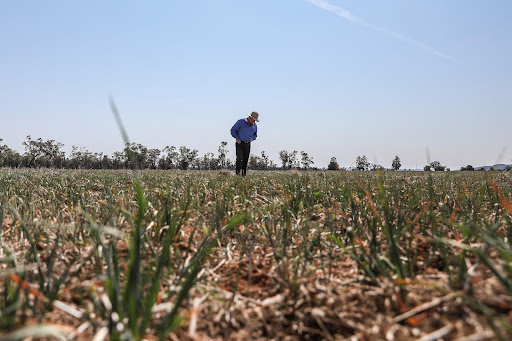Andrew and Megan Mosely at Etiwanda
Resilience in the Rangelands | UPDATED November 2023
‘In the last few good seasons, the results have really started to show what can happen when you’ve got the foundation right and get some of these practices in place. It doesn’t happen overnight.’ – Andrew Mosely
Andrew and Megan have been applying a holistic approach to farming for two decades on their property 90 kms south of Cobar, and are now seeing their hard work and investments paying off. Their family has developed a deep connection to the area and the landscape since Andrew’s grandfather drew ‘Manuka’ in a returned serviceman’s ballot in 1949. When Andrew and Megan took over in 1997, the farm was running a wool operation and at the time faced significant challenges including degradation in the landscape through capped soils and Invasive Native Scrub (INS), which was inhibiting the growth of grass and profitability of the business. They started questioning what was going on, and looking for answers, with the goal of creating a more productive, resilient and prosperous farm.
Andrew and Megan now run White Dorper meat sheep, semi-managed Rangeland goats, and Red Angus cattle on the property. Grazing management is their key focus, however they haven’t created a standardised cell-grazing set up, and have instead taken an approach of creating better wire and water infrastructure in certain places to create targeted intensive animal impact from the three enterprises (sheep, goats, cattle), based on what that part of the landscape needs at that time. They now have 70-80 of these paddocks in their system.
Since making these changes, the Moselys have noticed they have more high-succession and better quality perennial grasses, and less capping and bare ground. Generally, their property has more life than it used to.
‘When you start to look down, and look at the species and what’s going on, there’s a huge difference between this managed environment and the unmanaged conventional type environments in a similar area.’ Megan
The Moselys saw the Rangelands Living Skin (RLS) project as a great opportunity to trial some new practices in a structured way, to continue to move the landscape forward, and to learn more about and improve their soil biology.
They see these management approaches as a real opportunity in the rangelands environment. In addition, they are interested in the potential of ecosystems services markets to encourage landscape improvements, however they wish to see these schemes incentivise meaningful actions in the landscape, and to take a more holistic approach to landscapes and enterprises.
One of Andrew and Megan’s key motivators going forward is to take their business to the ‘next level’ to be able to accommodate their daughters if they choose to be involved. Andrew and Megan’s daughters have grown up being exposed to Holistic Management, and this way of thinking is now second nature to them, in the way that they see the country and how they handle stock. Everyone working on the farm continues to develop their knowledge through courses undertaken together which is helpful for a shared understanding. They currently work on the farm with one full-time employee and would like to enable their two daughters to work in the business if they choose to in the future.
They have found the project to be really helpful in planning for this, and access through the project to business coaching and benchmarking has already made a huge impact on their operation. Having a coach with experience in family farming to bounce ideas off and to suggest ideas that perhaps they haven’t thought of before has been extremely helpful. In addition, Megan adds that it’s great to have someone who helps to coach them through their thinking about how they are making decisions, rather than telling them what to do. They have really enjoyed this process, and working with someone who has a lot of experience on extensive properties which often don’t follow ‘textbook’ behaviours. Similar to the other core producers, they have found being involved in the group and having other people’s insights in a peer setting has been helpful to find new ways of thinking.
‘We’ve all got our blind spots and hopefully that’s the idea with having the four of us involved, we can maybe highlight some of those blind spots and move the whole lot of us forward.’ Andrew
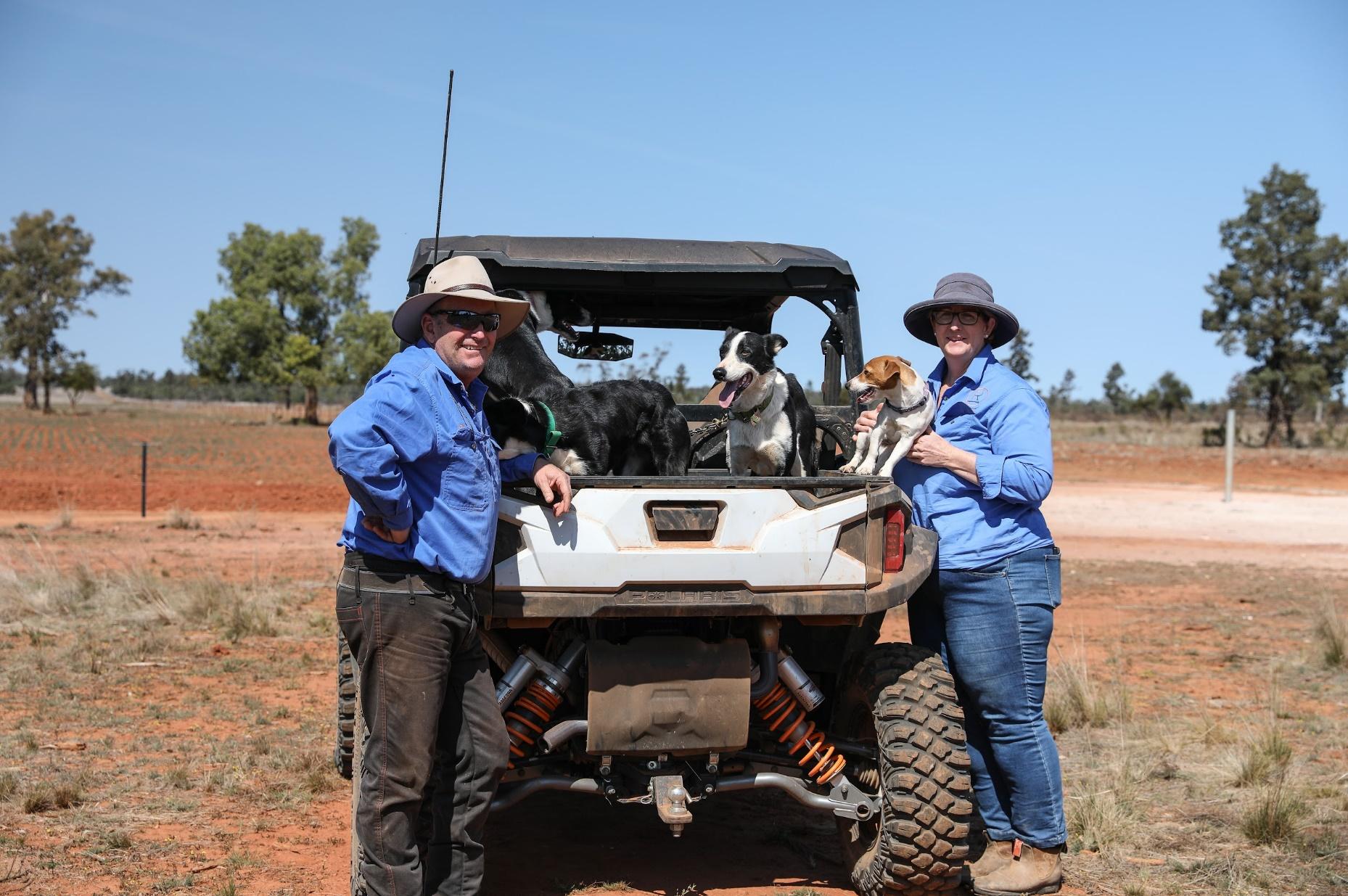
(L-R) Andrew and Megan Mosely
Farm facts
Location
Wongaibon Country, Cobar, NSW
Climate
Hot dry summer, cold winter
Average Annual Rainfall
426 mm*
Agro-ecological Region
Dry**
Property Size
20,000ha
Elevation
230-260m
*Sourced from MyClimateView.com.au. Farmer reported 390-400 mm.
Social Structure
Family farm, owned by Andrew and Megan
Enterprise Type
Semi-managed Rangeland goats, White Dorper sheep, and Red Angus cattle
Landscape
Rangelands
Soils*
Red loam to red sandy loam
*Learn more about soil classifications at https://www.soilscienceaustralia.org.au/asc/soilkey.htm
Practices for improving soil and landscape
The Moselys undertook Holistic Management training in the 90s, which started to answer some of their questions about declining productivity, biodiversity and increased runoff. They began to implement changes on the farm, including adding high-quality fencing to get some control over grazing and rest periods, and they started resting the country following rain events just to see what happened. They felt like they were ‘spinning their wheels’ at times during the first 15 years, with limited infrastructure and paddocks. However, they continued fencing and taking steps towards their goal for the property, and with the return of a few good seasons of rainfall big changes were evident. They have observed that they could grow more grass using grazing management techniques that provide the landscape with the opportunity for rest and recovery based on the condition of the landscape at the time. They continue to make changes, see improvements, and to ask questions.
To date, they have found that grazing management has had the most significant impact in regenerating the landscape, over the largest area. Their grazing management is supported by a good quality total grazing pressure (TGP) fence around the perimeter and between paddocks that they can use to ‘bunch’ animals up in specific locations, to keep them moving and get beneficial animal impact across the landscape.
Because of their intensive rotational grazing, Andrew and Megan are currently able to run twice as many cattle (around 10,000 DSE) than prior to their management change, and to the regional average ), and combined with the sheep and goats are able to run 10-20,000 DSE. They note that this is partly due to extra grass growth from the last few years of good rain, but largely due to their grazing management and the combination of enterprise types working together. For example, the family has been using goats as a ‘landscaping tool’ for a long time as they eat the shrub species and help to open up the landscape again. This mix of animals in the landscape also provides them with flexibility and allows them to be responsive to changing conditions, and forms an essential part of their strategy.
Mechanical Intervention
If the season permits, the Moselys grow grain in other areas, that are licensed for cultivation. They then store and sell the grain for extra financial stability and flexibility to adapt to circumstances, which they were able to do in the last drought. They have also found that combining mechanical intervention with cropping ‘pushes the landscape forward quicker than just the stock.’ Andrew explains that it can be a chicken and egg scenario if you haven’t got enough grass in one location to create density in the mob, so they use the mechanical intervention, such as direct drilling oats or the multispecies pasture, and use only a small amount of fertiliser to ‘tickle the system’ to get it moving. They are not interested in using large amounts of fertiliser because they find it is ‘not economical, and doesn’t do the soil any good’. Now they are focussed on improving soil biology and are trialling using biological stimulants on the seed as they sow it.
No-Kill Cropping
Bruce Maynard visited Etiwanda in 2022 to implement some No-Kill Cropping trials as demonstration sites. This involved single-tyne strips in hard-capped, compacted soils. Their experience so far has been that they need to create more disturbance. Creating disturbance as a once-off and then moving to a different area to give the soil a chance to re-balance has been successful. As a result, they have seen better grass species become established, and greater grass diversity.

Image 6. An area that has been cropped the previous year and rolled with a crimp roller. Green growing annuals despite only receiving less than 100 mm of rainfall (Image source Grow Love Project).

Image 7. An area that has been cropped previously and rolled with a crimp roller (Image source Grow Love Project).
Rangelands Living Skin trial practices
As part of the Rangelands Living Skin project, producers are running low-cost trials of various, scalable practices that they hope will offer multiple benefits. The trials include a trial chosen by the farmer (demonstration site), as well as replicated trials across the farms, and remote sensing data to reflect grazing management.
Farmer-led: Multispecies pastures
Andrew and Megan started trialling multispecies a couple of years ago. They have seen encouraging results so far and are excited about the ‘huge opportunities’ of this method. In addition to anecdotal improvements in soil health, they find oats, in particular, provide them with additional options for their livestock. Being in a semi-arid environment, oats provide a quality forage source that allows for increased rates of weight gains to be achieved by livestock. They highlight that the multispecies areas are integrated into the overall design of the farm by being managed more intensively than other extensive areas to be able to hold and feed stock well, which also has the benefit of having the stock easier to access and sell.
One approach that the Moselys trialled through the RLS project is running replicated trial sites of multispecies pastures and annual legumes. The multispecies trial includes one plot of a multispecies cropping mix of oats, vetch, a legume to fix nitrogen and provide a protein-rich feed source, cereal rye for carbon sequestration and buster radish to open up the soil structure, along with good native perennials. The other two plots included oats and a biostimulant, and oats with no biostimulant. These were sown in strips into a tilled paddock, in a randomised block design. In the same paddock, an uncleared/unimproved area, and cleared but not sown areas, were monitored as controls.
The annual legumes trial included five different hard-seeded legume species (Serradella, Casbah Biserrulla, Bladder Clover, Gland Clover and a legume blend including Cavalier Spineless burr medic 40%, Bartolo Bladder clover 40% and Cobra Balansa clover 20%). In May 2023 Legumes were sown into the existing replicated trial area, in small plots 3 x 40m. Three replicates of each species were sown in a randomised block design. Prior to sowing, cover, biomass, greenness and composition were recorded in 3 x 0.25m2 quadrats within each plot. Legume establishment will be measured in each plot 4-8 weeks after the sowing date, depending on rainfall. Legume productivity and persistence will be monitored in Spring 2023.
Replicated Plot Trials
Replicated plot trails of biostimulants are being undertaken across the four participating Rangelands Living Skin farms. The replicated plot trials provide an opportunity to investigate the soil and plant benefits of various treatments on a small scale in a scientifically rigorous manner.
The treatments to be applied were selected in collaboration with the core producers, and in this case include biological inputs (bioprimers) and natural soil conditioners (biochar). Each replicate has been randomised to address any potential bias that may present in the results due to variations in the soil or alike.
The treatments at Etiwanda included:
- Control – no application of treatments or sowing of new species. This is the reference site to which the other treatments are compared with.
- Bioprimer (Solid) – application of a solid biological stimulant material to existing vegetation/soil. The solid bioprimer was applied by hand at a rate of 250kg/ha.
- Bioprimer (Liquid Foliar) – application of a liquid biological stimulant material to existing vegetation. The liquid biofoliar spray was applied using a 15L knapsack sprayer at a rate of 5L/ha.
- Biochar – application of biochar to existing vegetation/soil. Biochar was applied at a rate of 10 t/ha.
At each site, three replicates of each treatment were established in mid-August 2022 in a randomised, blocked design (Image 10).
Andrew and Megan wanted to include biochar in the replicated trials as they have an issue with woody shrubs now dominating parts of their pastures, reducing the ability of native grasses to stabilise the soil and provide nutrition for their stock.
In the future, the Moselys hope to create biochar from these homegrown materials but want to know the influence of this on their soils before expanding to larger-scale production. Andrew says ‘With 20,000 hectares, we can’t afford to use fertilisers. We want to use what is available on our farm to create bio-stimulants and conditioners to help cover a huge area.’
Remote Sensing of Grazing Management
Changes in ground cover in response to the improved grazing management (managing stocking rates and resting paddocks) on Etiwanda over the last 26 years are being assessed using remote sensing data. Using Landsat spatial data, the total ground cover on Etiwanda is compared with similar land types within 10km of the property (benchmark areas), for each season since 1989 2001. This method allows the impact of management to be separated from some of the temporal and spatial variability associated with seasonal conditions and different land types. A positive trend in this difference in cover between Etiwanda and the benchmark area from the time of changed grazing management would indicate positive impacts of this change.
Early observations
The Moselys acknowledge that one of the key challenges with this project is that the practices they are implementing now will take years to yield results. It’s hard to quantify the results at this point in time, but the core producers will likely continue to monitor for ongoing results and adapt accordingly. That said, Megan believes that if they can stop the landscape from going backwards in dry years by retaining ground cover and reducing livestock numbers, the landscape will leap forward again the next time it rains.
The project team is often in the field collecting data, and we’ll be adding more information about the trial results in 2024. Sign up to our Newsletter to receive updates.
Acknowledgements
This case study was prepared as part of the Rangelands Living Skin Project. The Rangelands Living Skin is a four-year project in the NSW Rangelands co-designed by farming families, scientists and collaborators to evaluate cost-effective practices – chosen by producers – for fostering a productive rangeland system now and into the future.
In this project, four core producers trialled a range of practices to improve landscape health, livestock production and business performance to ultimately achieve greater resilience from year to year. The project will create an evidence base to inform the widespread adoption of practices that benefit soil, plants, animals and people – the living skin of the rangelands.
Led by the NSW Department of Primary Industries and funded by Meat & Livestock Australia, this project is a significant investment in the southern rangelands. The Rangelands Living Skin project is a truly collaborative project involving producers, industry, government, academia, researchers, educators and extension specialists, and carbon aggregators.
Soils for Life gratefully acknowledges the generous contributions of the partner organisations in this project. We also acknowledge that the contents of this case study do not necessarily reflect the views of these contributors.

For more information
Follow us for the latest
If you have any questions, get in touch at [email protected].



